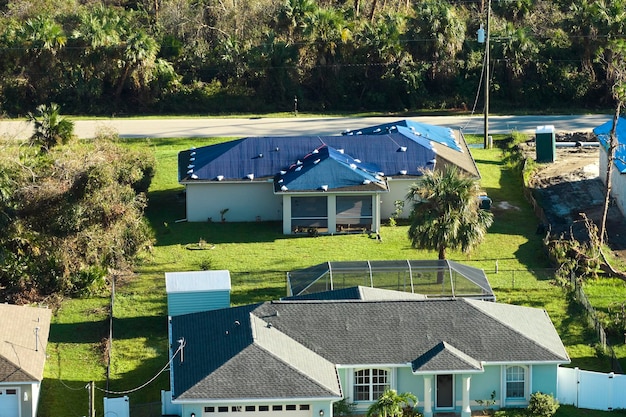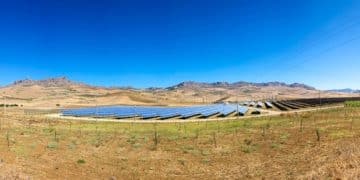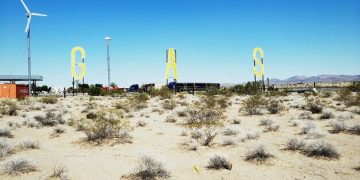Long-Term Economic Benefits of Renewable Energy in the US

Investing in renewable energy infrastructure in the US offers long-term economic benefits, including job creation, reduced healthcare costs due to decreased pollution, energy independence, technological innovation, and enhanced energy security, fostering sustainable economic growth.
The shift towards renewable energy is gaining momentum, and understanding what are the long-term economic benefits of investing in renewable energy infrastructure in the US is crucial for policymakers, investors, and citizens alike. This article explores those benefits, examining how renewable energy can drive economic growth, create jobs, and improve the overall quality of life for Americans.
Renewable Energy: A Catalyst for Economic Growth
Renewable energy is more than just an environmental solution; it’s a powerful engine for economic growth. Investing in renewable energy infrastructure stimulates various sectors, creating a ripple effect throughout the economy. From manufacturing and construction to research and development, the opportunities are vast and varied.
But how exactly does renewable energy drive economic growth? Let’s delve into the specifics.

Job Creation in the Renewable Energy Sector
One of the most significant economic benefits of investing in renewable energy is the creation of numerous jobs. These jobs span across various skill levels, from engineers and technicians to construction workers and sales personnel. Unlike traditional fossil fuel industries, renewable energy projects are often labor-intensive, requiring a larger workforce for installation, maintenance, and operation.
Consider the following points:
- Manufacturing: Factories producing solar panels, wind turbines, and other renewable energy components create manufacturing jobs.
- Construction and Installation: Installing solar farms, wind turbines, and geothermal plants requires a skilled workforce.
- Research and Development: Investing in renewable energy technologies spurs innovation, leading to jobs in research and development.
- Maintenance and Operation: Renewable energy facilities require ongoing maintenance and operation, providing long-term employment opportunities.
Ultimately, the renewable energy sector fosters job growth across multiple disciplines and skill levels, contributing to a more robust and diversified economy.
Reduced Healthcare Costs and Improved Public Health
Investing in renewable energy also leads to significant reductions in healthcare costs. Traditional fossil fuels release harmful pollutants into the air, contributing to respiratory illnesses, cardiovascular diseases, and other health problems. By transitioning to cleaner energy sources, we can greatly reduce these pollutants and improve public health.
- Cleaner Air: Renewable energy reduces air pollution, leading to fewer respiratory illnesses.
- Reduced Healthcare Spending: Fewer illnesses mean lower healthcare costs for individuals and the government.
- Improved Quality of Life: Cleaner air and water contribute to a higher quality of life for everyone.
The transition to renewable energy yields tangible health benefits and reduces the economic burden associated with pollution-related healthcare costs. This creates a healthier population and a more productive workforce.
In conclusion, investing in renewable energy infrastructure leads to job creation across various sectors and significantly reduces healthcare costs by mitigating pollution-related illnesses, fostering a healthier and more productive society.
Enhancing Energy Security and Independence
The move towards renewable energy sources significantly strengthens the nation’s energy security and independence. Relying less on imported fossil fuels makes the US less susceptible to international market volatility and geopolitical tensions. By harnessing domestic renewable resources, the nation can ensure a more stable and predictable energy supply.
Energy security and independence are critical for long-term economic stability. Let’s explore how renewable energy achieves this.
Reducing Reliance on Foreign Energy Sources
One of the most compelling arguments for investing in renewable energy is the potential to reduce dependence on foreign energy sources. The US has abundant renewable resources, including solar, wind, geothermal, and hydropower. By developing these resources, the nation can decrease its reliance on imported oil and gas, which are subject to price fluctuations and geopolitical instability.
- Price Stability: Renewable energy prices are more stable than fossil fuel prices, which can fluctuate wildly based on global events.
- Geopolitical Security: Reducing reliance on foreign energy sources strengthens national security and reduces vulnerability to international conflicts.
- Domestic Resource Utilization: Utilizing domestic renewable resources creates jobs and stimulates local economies.
Decreased reliance on foreign energy leads to greater price stability, enhanced geopolitical security, and the creation of domestic economic opportunities. This shift strengthens the nation’s overall economic resilience.
Strengthening the National Grid and Reducing Vulnerability
Investing in renewable energy also strengthens the national grid and reduces vulnerability to disruptions. Decentralized renewable energy systems, such as rooftop solar panels and local wind farms, can enhance grid resilience by distributing power generation across multiple sources. This reduces the risk of widespread outages due to a single point of failure.
- Decentralized Power Generation: Distributing power generation across multiple sources reduces the risk of widespread outages.
- Smart Grid Technologies: Integrating smart grid technologies with renewable energy systems improves grid efficiency and reliability.
- Energy Storage Solutions: Investing in energy storage solutions, such as batteries, enhances grid stability and ensures a reliable power supply.
A robust and resilient energy grid is essential for economic stability. By diversifying energy sources and investing in grid modernization, the US can reduce the risk of disruptions and ensure a reliable power supply for businesses and consumers.
By reducing reliance on foreign energy sources and strengthening the national grid, investing in renewable energy enhances energy security and independence, safeguarding the nation’s economy against external shocks and ensuring a stable energy supply.

Technological Innovation and Global Competitiveness
The renewable energy sector fosters technological innovation and enhances global competitiveness. As companies compete to develop more efficient and cost-effective renewable energy technologies, they drive innovation in fields such as materials science, engineering, and energy storage. This technological progress can then be applied to other sectors of the economy, boosting overall competitiveness.
Technological innovation is a key driver of economic growth, and the renewable energy sector is at the forefront of this innovation.
Creating a Hub for Innovation and Development
Investing in renewable energy fosters a vibrant ecosystem for innovation and development. Research institutions, universities, and private companies are all working to develop new and improved renewable energy technologies. This creates a hub for innovation, attracting talent and investment from around the world.
Consider the following ways it does this:
- Research Grants: Government funding for renewable energy research and development encourages innovation.
- Public-Private Partnerships: Collaborations between public institutions and private companies accelerate the development and deployment of new technologies.
- Incubator Programs: Incubator programs support startups in the renewable energy sector, providing them with resources and mentorship.
These initiatives accelerate technological progress, creating new opportunities for economic growth and enhancing the nation’s competitive edge.
Enhancing Global Competitiveness in Renewable Energy Technologies
Investing in renewable energy enables the US to become a global leader in renewable energy technologies. As domestic companies develop cutting-edge technologies, they can export these technologies to other countries, creating new export markets and boosting the nation’s trade balance. Increased trade and technological leadership creates more jobs and increases our overall GDP.
- Export Opportunities: Domestic companies can export renewable energy technologies to other countries, creating new export markets.
- Intellectual Property: Developing new technologies creates valuable intellectual property, which can be licensed or sold to other companies.
- Attracting Foreign Investment: A thriving renewable energy sector attracts foreign investment, further stimulating economic growth.
Being a leader in renewable energy technologies also creates jobs and grows our economy.
The renewable energy sector is a catalyst for technological innovation, driving advancements in various fields and enhancing the nation’s global competitiveness. By supporting research and development, the US can position itself as a leader in this rapidly growing industry.
Attracting Investment and Stimulating Local Economies
Renewable energy projects attract significant investment and stimulate local economies. These projects often require substantial upfront investment, which can provide a boost to local businesses and create jobs in construction, manufacturing, and other related industries. Additionally, renewable energy facilities can generate revenue for local governments through property taxes and other fees.
These benefits are important for rural communities that often struggle with economic development. The investment brings new taxes to the counties, new jobs, and new life to the community.
Boosting Rural Economies
Renewable energy projects can be particularly beneficial for rural economies. Rural areas often have abundant renewable resources, such as solar and wind, but lack the infrastructure and investment needed to develop these resources. By attracting investment in renewable energy projects, these areas can revitalize their economies, create jobs, and improve the quality of life for residents.
- Job Creation: Renewable energy projects create jobs in construction, maintenance, and operation.
- Increased Property Values: Renewable energy facilities can increase property values for local landowners.
- Tax Revenue: Renewable energy projects generate tax revenue for local governments, which can be used to fund schools, infrastructure, and other public services.
Rural economies are boosted because of these investments from renewable energy facilities.
Encouraging Private Sector Investment
Government policies and incentives can encourage private sector investment in renewable energy. Tax credits, grants, and loan guarantees can make renewable energy projects more financially attractive to private investors. By creating a favorable investment climate, the government can accelerate the deployment of renewable energy technologies and stimulate economic growth.
- Tax Credits: Tax credits reduce the cost of renewable energy projects, making them more attractive to investors.
- Grants: Grants provide direct funding for renewable energy projects, reducing the need for private investment.
- Loan Guarantees: Loan guarantees reduce the risk of investing in renewable energy projects, encouraging private lenders to provide financing.
Overall this investment from the private sector greatly increase the job market and the government also makes money.
As renewable energy projects take shape, they not only generate clean energy but also serve as catalysts for community development, fostering long-term economic health and resilience.
Infrastructure Development and Modernization
Investing in renewable energy infrastructure requires the development and modernization of the nation’s energy grid. This includes upgrading transmission lines, integrating smart grid technologies, and deploying energy storage solutions. These investments can improve grid efficiency, reduce energy waste, and enhance the reliability of the energy supply.
Modernizing these technologies is going to provide more jobs and help prevent failures in the aging infrastructure.
Upgrading the National Grid to Support Renewable Energy
The existing national grid was designed to transport electricity from large, centralized power plants to consumers. However, renewable energy sources are often located in remote areas, such as the Great Plains, where wind resources are abundant. Upgrading the grid to support renewable energy requires building new transmission lines and modernizing existing infrastructure.
- Transmission Lines: Building new transmission lines to transport electricity from renewable energy facilities to consumers.
- Smart Grid Technologies: Integrating smart grid technologies to improve grid efficiency and reliability.
- Energy Storage Solutions: Deploying energy storage solutions to balance the intermittent nature of renewable energy sources.
Improving Grid Efficiency and Reducing Energy Waste
Modernizing the grid can also improve energy efficiency and reduce energy waste. Smart grid technologies can monitor energy demand in real time and adjust power supply accordingly, reducing the need for excess capacity. Additionally, energy storage solutions can store excess energy generated by renewable sources and release it when demand is high, reducing the need for fossil fuel peaker plants.
- Smart Meters: Installing smart meters to provide consumers with real-time information about their energy consumption.
- Demand Response Programs: Implementing demand response programs to encourage consumers to reduce their energy consumption during peak periods.
- Energy Storage: Deploying energy storage solutions to store excess energy generated by renewable sources.
Investing in grid modernization is essential for supporting the growth of renewable energy and improving the overall efficiency and reliability of the nation’s energy system. As outdated components are replaced with more efficient and intelligent technologies, the grid becomes capable of handling the fluctuating supply from renewable sources while minimizing energy waste.
This results in a more sustainable and cost-effective energy landscape for the nation.
Environmental Benefits and Sustainable Development
Investing in renewable energy infrastructure yields significant environmental benefits and promotes sustainable development. By reducing greenhouse gas emissions, renewable energy helps mitigate climate change and protect the environment for future generations. Additionally, renewable energy facilities have a smaller environmental footprint than traditional fossil fuel plants, reducing air and water pollution.
Protecting our environment is going to create a better life for the current and future generations .
Reducing Greenhouse Gas Emissions
One of the most significant environmental benefits of renewable energy is the reduction of greenhouse gas emissions. Fossil fuels release carbon dioxide and other greenhouse gases into the atmosphere, contributing to climate change. Renewable energy sources, such as solar and wind, produce little to no greenhouse gas emissions, helping to mitigate climate change and protect the environment.
- Carbon Dioxide: Reducing carbon dioxide emissions to mitigate climate change.
- Other Greenhouse Gases: Reducing emissions of other greenhouse gases, such as methane and nitrous oxide.
- Air Pollution: Reducing air pollution from fossil fuel plants, improving air quality and public health.
Promoting Sustainable Development
Renewable energy promotes sustainable development by providing clean, reliable energy while minimizing the impact on the environment. Sustainable development meets the needs of the present without compromising the ability of future generations to meet their own needs. By investing in renewable energy, we can create a more sustainable and prosperous future for all.
- Resource Conservation: Conserving natural resources for future generations.
- Environmental Protection: Protecting the environment from pollution and degradation.
- Economic Growth: Promoting economic growth that is both sustainable and equitable.
Investing in renewable energy infrastructure delivers significant environmental benefits and promotes sustainable development. By reducing greenhouse gas emissions and minimizing the environmental impact of energy production, renewable energy helps create a cleaner and more sustainable future for future generations.
| Key Point | Brief Description |
|---|---|
| 💰 Job Creation | Spurs employment in manufacturing, construction, research, and maintenance sectors. |
| ⚕️ Health Benefits | Reduces air pollution, lowering healthcare costs and improving public health. |
| 🛡️ Energy Security | Decreases reliance on foreign energy sources, enhancing national energy security. |
| 💡 Innovation | Drives technological advancements, boosting global competitiveness. |
FAQ
▼
Renewable energy investments create jobs in manufacturing (solar panels, wind turbines), construction/installation of renewable energy facilities, research/development of new tech, and ongoing maintenance/operation of these facilities.
▼
Renewable energy reduces the emission of harmful air pollutants. Fewer pollutants means a decrease in respiratory and cardiovascular illnesses, leading to decreased healthcare spending for individuals and the government.
▼
Energy security refers to a nation’s ability to secure a stable and reliable energy supply. Renewable energy improves energy security by diversifying energy sources and reducing reliance on foreign sources, which are subject to price volatility.
▼
The renewable energy sector drives innovation by incentivizing the development of more efficient and cost-effective technologies. This includes creating grants and public-private partnerships, accelerating tech progress and enhancing competition globally.
▼
Switching to renewable energy will lead to a reduction of greenhouse gas emissions, helping to combat climate change. These facilities have less of an environmental footprint than fossil fuel power plants reducing air and water pollution.
Conclusion
Investing in renewable energy infrastructure in the US presents a compelling pathway to sustained economic growth, energy independence, technological advancement, and environmental stewardship. Renewable energy not only provides a cleaner and more secure energy supply but also fuels job creation, reduces healthcare costs, and fosters innovation, making it a sound investment for the long-term prosperity of the nation.





